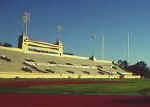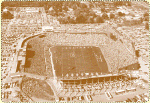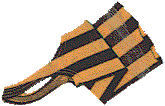|
|
|||||
|
|
|
|
|
||
| . | |||||
. |
| More MEMOIRS OF A MICKEY MOUSE FAN © a fan's History of the American Football League © |
|
|
|||||
|
|
|
|
|
||
| . | |||||
. |
| More MEMOIRS OF A MICKEY MOUSE FAN © a fan's History of the American Football League © |
. |
|
| . |
CHAPTER 2 - 1960: In July 1960, less than a year after the August 1959
meeting of the "Foolish Club", the American Football League pumped up
its first Spalding Cushion Control football (later called the Spalding
J5-V), and the Boston Patriots played an exhibition game against the Buffalo Bills. |
Braves (Nickerson)
BU Field  |
Polo Grounds  |
|
Jeppesen Stadium |
War Memorial Stadium |
||
Bears
Stadium |
Cotton Bowl |
||
Los Angeles Coliseum |
Original Kezar Stadium |
||
| Stadium photos from Bruce D. Krauss | |||
|
In searching for its head coaches, the AFL's
approach was similar to that used in stocking its teams with players: some from the
college ranks, some "NFL rejects", and some "free agents".
They even had a couple of ex-CFL coaches in the mix. The league was divided in two, East and West. In the Eastern Division, Lou Saban went from a perfect 8 - 0 record at Western Illinois University to coach the Boston Patriots; the Houston Oilers chose Lou Rymkus, a former star with Notre Dame, the Redskins and the Browns, and a former assistant coach with the LA Rams and the CFL's Calgary Stampeders; former star quarterback Sammy Baugh was head football coach at Hardin-Simmons University in Abilene, before becoming the New York Titans' head coach; and Buster Ramsey, a former pro lineman and a defensive coach for the Cardinals and the Lions, led the Buffalo Bills. In the Western Division, the Denver Broncos hired Frank Filchock, a one-time journeyman pro quarterback whose only head coaching experience was with the CFL's Saskatchewan club; while to coach his Dallas Texans, Lamar Hunt selected Hank Stram, who had been an offensive coordinator at Purdue, SMU and the University of Miami Hurricanes. Barron Hilton initially wanted Frank Leahy, but instead hired a man who would forever change the way professional football was played: Sid Gillman, who coached the Rams for five years before coming to the Los Angeles Chargers. Meanwhile, the eight-man ownership team of the Oakland Raiders settled on the legendary Eddy Erdelatz, the U.S. Naval Academy's former head coach. The early AFL's ideal schedule was a consequence of the eight-team makeup of the league. Whether that structure was fortuitous or a brilliant idea of Lamar Hunt's, the end result was perfect: in a fourteen-game schedule, each team played every other team in the league twice, once at home and once away. In their own home stadium, every year, fans of an AFL team got to see every other team in the league, with all its stars. Thus, they could enjoy and judge the merits of those teams and players first-hand, unlike the NFL, in which some teams were not only not played at home, but not at all. This left the NFL fans to depend on other teams' home-town reporters to tell them how great the players were. A further benefit of the AFL's structure and scheduling was that each team played essentially the same schedule, eliminating arguments about which team had the easier road to the championship game. The team with the best record in each division obviously also had the best record against common opponents, against division opponents, etc. |

 
 . . . 
 
 |
||
|
Before starting its first season, the AFL established rules of play to include the option of a two-point conversion after touchdowns, becoming the first professional league to adopt a rule that was by then followed by virtually all organized football, except the NFL. Noting instances of confusion in NFL games when the scoreboard clock showed playing time left, but the on-field officials said the game was over, the American Football League instituted the scoreboard clock as the official clock in all games. The AFL was also the first Professional Fooltball league to have its players' names displayed on the backs of their jerseys for easier identification by fans and media, an idea apocryphally attributed to Chargers' head coach Sid Gillmaan. |
|||
|
Off the field, the American Football League followed a course that would help "small-market" teams compete financially, through revenue-sharing of home gate receipts 60% - 40% with visiting teams, a practice disdained by the NFL, as well as through its seminal ABC-TV contract. Much is made of the claim that the AFL was not viable until its 1965 contract with NBC-TV 'saved' the League. However, in 1960, before the NFL ever had a league-wide national contract, the American Football League landed a contract with ABC that guaranteed each of its teams one and a third million dollars, before a single fan came through the turnstiles. |
|||
Because of his media connections, Wismer was also able to convince the press services UPI and AP to give equal coverage to the AFL. This too, was a tremendous accomplishment, in light of the biased manner in which most sports media derided or simply ignored the AFL. Thus papers like the New York Times and the Detroit Free Press, even though their local writers scorned the new league, carried AP and UPI AFL line scores, and sometimes even feature stories on the AFL. On July 8, at various locations around the country, the eight American Football League teams opened training camps. Just before camp started, a court ruling had voided a claim by the NFL’s Rams for LSU’s Heisman Trophy winner Billy Cannon, allowing Cannon to be signed by the Houston Oilers, and setting the precedent for the signing of other college stars by the AFL. These were joined by former NFL players, CFL players, and amateurs of all stripes who aspired to be professional football players. For example, the Oilers had Heisman Trophy winner Cannon, but they also had former schoolteacher Charlie Hennigan, who kept his teacher's pay stub in his helmet for motivation. Both ended up being AFL superstars. Exhibition games were scheduled between AFL teams, and some were played against Canadian Football League squads. The games were optional for season ticket holders (the going rate for Bills’ exhibitions being $5!) with many games simply intra-squad contests to help winnow out the huge rosters and choose the potential contributors. Squads as large as 200 had to be reduced to the limit settled on in August: 35 players per team. Charlie McMahon's story is just one of the many experienced by AFL hopefuls. As he tells it, in early July of 1960 he was one of about 200 players who passed through the first Denver Broncos training camp at the Colorado School Of Mines campus in Golden, Colorado. They literally had auto mechanics, farmers, stock clerks, high school football coaches (McMahon was one), Hollywood stuntmen, etc. come out of the woodwork for an opportunity to play pro football. Some were cut and others fled in the night before another batch would be brought in the next day. It was a revolving door process and no one was safe except two or three players (Bud McFaddin, Frank Tripucka). McMahon relates the following: "The team was going to carry two QBs and it came down to George Herring and myself as Tripucka's backup. We had an intrasquad scrimmage in Pueblo with Herring quarterbacking one team and myself the other with the team backup to be decided in the scrimmage. I threw for one touchdown and my team was ahead 7-0 when I was injured in the second quarter. Fearing injury to Tripucka, the coach Frank Filchock decided to let Herring QB both teams. While I was at the local hospital getting sewed up Herring won the job and as a result he was also named the team punter. The team asked me to stay on as the scout team QB on the taxi squad and backup if either QB were injured. The minimum AFL salary was $7,200 which was twice what I made for 10 months of coaching, so the decision was easy for me. Well, Tripucka literally played every single offensive down that season. The only action Herring saw was punting so I never suited up for a game all season and was released the following season when the team signed a Lousiana Tech QB to a no cut contract (Don Breaux). Buffalo asked me to come up for a tryout but by then we were expecting our second child so I went back to coaching never having played a down in a regular game. I tell you this not out of bitterness but with a grateful heart. The year will always be special to me and my wife. I am thankful to Lamar Hunt and Bud Adams for their foresight, and pocketbooks, for establishing the AFL and allowing all of the journeymen wanna-be's to attempt to live a dream. If my family had the bucks of the aforementioned gentlemen I would have paid the team to let me continue playing. I am in the 1960 team picture below, but nowhere else in their archives that I can find." . |
|||
In addition to the
excitement of the games themselves, the AFL fans' view of football was enlivened by
elements like the Broncos' vertically striped socks, and the lightning bolts and
powder-blue shirts of the Chargers. Even the umpires and referees looked different,
with red-striped jerseys and an AFL logo on the chest. The head referee wore a red
cap with the AFL logo on the front. The Chargers' strikingly unique uniforms set the
standard for AFL style, while the Texans' red, white and gold uniforms became a hallmark
of the team. The only significant change in that uniform from day one until today was the
replacement of the team's "Texas" helmet logo with the Chiefs' "arrowhead"
insignia, and the addition of an AFL shoulder patch honoring founder Lamar
Hunt. |

 
 |
||
The first American Football League season had high-scoring games like
the Oilers-Titans game above, the week twelve Bills-Broncos 38-38 tie on
November 27th, and the Chargers' 52-28 win over the Raiders on the
same day. It also had four shutouts, and some tight defensive battles. It had
blowouts like the Raiders' 48-10 demolition of the Broncos in week five, with Oakland
scoring 31 points in the fourth quarter; but it also had nail-biters like the Bills' "Hallowe'en
game", a 25-24 win over the Oilers in week eight, on a last-minute
Billy Atkins field goal. |
||||||||||||||||||||
 |
 |
 |
 |
 |
||||||||||||||||
| Card images from Vintage Football Card Gallery | ||||||||||||||||||||
Because another league was in competition for the class of 1961's college stars, the American Football League draft for 1961 graduates was actually held in 1960, with a six-round telephone draft on November 23rd, that saw the Buffalo Bills select Auburn's Ken Rice as the overall first draft pick. The draft was completed on December 5th and 6th, and included Georgia Tech's t Billy Shaw (Bills), and Boston College's t Larry Eisenhauer (Patriots). The Pats also signed Southern Illinois University's g Houston Antwine. Draftees signed by the Chargers included Grambling's massive dt Ernie Ladd, Clemson dt Bill Hudson, and Indiana de Earl Faison. With Kansas State's de Ron Nery, an "NFL reject" and ex-CFLer who had joined the Chargers the previous year, this group was the first to earn the title "The Fearsome Foursome". That nickname later was "appropriated" by the NFL's Rams. Washington State hb Keith Lincoln also signed with the Chargers. From the same draft, the Dallas Texans would sign Michigan State's te Fred Arbanas, Texas Tech c E.J. Holub, Ohio State t Jim Tyrer, and SMU t Jerry Mays. Yet, to this day, NFL apologists claim that "The AFL didn't sign any good players until after the merger and the common draft." |
||||||||||||||||||||
 |
 |
 |
 |
 |
||||||||||||||||
Card images from Vintage Football Card Gallery |
||||||||||||||||||||
|
||||||||||||||||||||
|
||||||||||||||||||||
So the first champions of the new league were the Houston Oilers, in a state that had never had Professional Football, in a city that had never had a champion. Yet these distinctions are clouded by the fact that the Oilers of the mid-1990s were so poorly run that fans stopped coming, and owner Bud Adams, when he couldn't squeeze a new stadium from the community, moved the team. Further, he saw to it that no pro football team anywhere, leastwise Houston, could ever again be called the "Oilers". Sad that the team's mismanagement led its fans to forsake it. Sadder still that Bud Adams, who had had the foresight to join the "Foolish Club" and the gumption to fight the NFL for the rights to Cannon, didn't have enough respect for football history to at least let Houston keep its football heritage and the name "Oilers". |
||||||||||||||||||||
|
Adams remains an enigma. In spite of his contributions to the
American Football League, he chose not to have a ring made for his players after that first
championship year. Instead, according to Dr.
Steve Hennigan, Charlie's son, he gave them "championship fobs", shown above. Several years later, apparently chagrined, he gave rings to the
1960 team. Hank Stram‘s son Dale, good friends with Billy Cannon, relates that
Cannon and Adams did not like each other, and when Bud tried to give the ring to Billy, he
basically told him where to put it. Adams, not knowing what to do with the ring,
sent it to the “pro football” Hall of Fame, and there it remains.
|
||||||||||||||||||||
|
||||||||||||||||||||
|
||||||||||||||||||||
The following are representations of American Football
League team helmets, worn in 1960. |
||||||||||||||||||||
| . | ||||||||||||||||||||
 |
||||||||||||||||||||
 |
 |
|||||||||||||||||||
. |
| Patriots | Bills | Oilers | Jets | Dolphins | Broncos | Chiefs | Chargers | Raiders | Bengals |
| Click here for an all-time roster of American Football League players. | |||||||||
. |
|
|
 |
 |
 |
 |
|
|
Home . |
Helmet Hut |
Remember the AFL |
A F L Hall of Fame |
AFL-NFL Merger |
Players who Belong in the Hall of Fame |
| . | |||||
|
©2003
American Football
League Hall of Fame All rights reserved. Duplicate in any form you
like, if you're an AFL fan. You have the permission of the American Football League Hall of Fame. Please credit/link to: http://www.remembertheafl.com Last revision: 05 December 2024 ~ Angelo F. Coniglio, nospam.RemembertheAFL@aol.com |
|||||